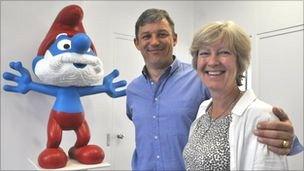Do Smurfs provide a model for a good society?
- Published
- comments
Smurf world record collector Stephen Parkes: 'They bring back lots of memories of my childhood'
Smurf fans around the world are celebrating the birthday of the famous cartoon strip's creator and awaiting a new blockbuster movie adaptation. But could the blue creatures offer a model for society?
There is a place where the neighbours are always willing to lend a hand, where everyone has a certain skill and is willing to employ it, without personal reward, for the benefit of everyone.
Before you think about checking out property prices in the area, bear in mind that the neighbours are blue, stand three apples high and live in mushroom-like houses.
The Smurfs, created in 1958 by the Belgian artist Pierre Culliford also known as Peyo, have proved hugely popular.
Their original name is Les Schtroumpfs, a word born during a meal Peyo was having with his friend in which, having temporarily forgotten the word "salt", Peyo asked him to pass the schtroumpf.
The two continued to talk, in French, using that word instead of recognised terms, and so the concept was born.
Later Peyo, already a successful artist whose father was English and mother Belgian, introduced little blue imp-like creatures into his existing stories about a medieval page and his sidekick, called Johan and Peewit.
The Smurfs - as these creatures are called in English, having been taken from the Dutch name De Smurfen - were an instant hit and following pleas from children, Peyo began a dedicated comic strip.
In 1981, Hanna-Barbera began to produce a cartoon series that resulted in 256 episodes, dubbed into some 30 languages and still being shown on more than 120 television channels around the world today.
Peyo died of a heart attack on Christmas Eve in 1992, but his family's work - his son Thierry runs his studio - continued.
Saturday is Global Smurfs Day, an event which celebrates the birthday of Peyo. It's also intended to whip up interest in the forthcoming Smurfs movie, due to be released in August starring Hank Azaria as Gargamel and Katy Perry as the voice of Smurfette - the first of a trilogy of films.

IMPS is run by Veronique Culliford and William Auriol
Each Smurf is known by their particular skill - Handy for the one who's good at DIY, Brainy for the clever one, Barber for the one who cuts hair etc. They're all organised by Papa Smurf, the eldest and wisest one, and their village is run as a collective without any use of currency.
Devoid of any particular cultural cues, the Smurfs have proved popular around the world.
"They are unique creations. They don't do politics or religion, they are multi-cultural, everybody around the world can recognise themselves in a Smurf," says Peyo's daughter, Veronique Culliford, who started International Merchandising, Promotion and Services in 1984 to look after the Smurf merchandising.
"Everyone can apply their very nice values of friendship, kindness and helping others to their own lives, regardless of where they come from."
But there is evidence of their genesis in 1950s Belgium. The lack of female characters - there are only three, and only one of them major - is down to the influence of the Catholic Church in education, says Willem de Graeve, director of the Belgian Comic Strip Center in Brussels.
Willem De Graeve, Belgian Comic Strip Centre: 'Individually, Smurfs are weak but united they are strong'
"That was a totally different era, when there was a very strong separation of genders in Belgium. This was a consequence of the Catholic education. It was not the done thing to show boys and girls having an adventure together."
And Peyo did occasionally use the Smurfs to convey political messages, such as in the King Smurf story, where one character seizes authoritarian control of the village in a metaphor that's anti-dictatorship.
There has even been debate about whether the artist intended the Smurfs to be a metaphor for socialism, but there is room for anyone with a political ideology that emphasises co-operation and community to interpret them through their own prism.
The Smurfs lived without money, using their individual skills for the common good, without individual reward, to ensure their community thrives.
You can even see echoes of the British government's Big Society idea, part of which encourages individuals to form community groups and engage in social action, particularly through volunteering, says Prof Ellis Cashmore, a sociologist from Staffordshire University.
"There are similarities between David Cameron's idea of the Big Society and what we see embodied in Smurf society.
"Cameron [is asking people to get] organised with their local community, have organic collectivity and work for each other, like we used to before industrialisation came along and fragmented society."
Smurfs have done overt politics more recently - in 2005, a Unicef advertisement featuring Smurfs was aired in Belgium, in which their village is bombed by aircraft, to raise funds for African children.
The Smurf empire is moving onto new platforms, taking advantage of the social gaming trend. A Smurf smartphone game targeted at women aged between 18 and 34 has had 12 million downloads so far.
Female gamers seem undeterred by the dearth of female Smurfs.